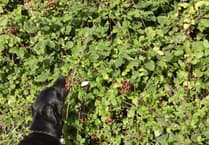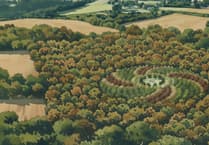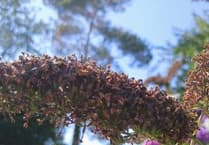A few lovely sunny days before we said goodbye to summer. My Choisya shrub rallied in this burst of warmth and started flowering again and I heard of someone’s rhododendron re- flowering, write Hazel Wedlake.
A wonderful year for conkers too, I even saw a double one in its casing. I was pleased to hear the National Conker championships still takes place. Conkers presented an unexpected hazard as they covered the slope down to the orchard it was like treading on marbles until I raked them aside.
In the veg garden, I’m pleased the Phacelia plant used for green manure has germinated nicely. It has wonderful blue flowers when mature which the bees like. At a recent horticultural event, we were advised the keep the soil microbes active during winter by leaving weeds to clothe it which is nature’s way, but not ours.
As it is I leave self seeded gorage, forget me not and native foxglove, but other invaders are quick to colonise such as red dead nettle, vetch and sun spurge. I’m also sympathetic to less frequently seen weeds in case they disappear, such as shepherd’s purse, fat hen and wild pansy. (Heartease) wild violet is rampant but as a food source for the fritillary butterfly I don’t mind, but vetch also popular with bees is not so welcome, its long white roots boring down out of reach.
I seem to remember being told that if the wild form of plant did well in your garden, then the cultivated should also do well. That holds true for euphorbia, the cultivated form of sun spurge but the pernicious ground elder, is not so welcome and whilst a variegated form has been developed, it is no more desirable! I was intrigued by its botanical name Aegopodium podagraria. It comes from the Greek for “goat’s foot” referring to its shape, but the Latin translates as“gout” for which it was used being high in vitamin C. Even so, I think we’d all be happy to manage without it, variegated or not.
Out on the footpath, early sun shone through hundreds of cobwebs draped across tall grass stems . Bumbling about amongst these were crane fly, active during August to October when they mate and lay their eggs giving rise to leather jacket larvae in the spring which can do considerable damage eating grass roots. How lushly the grass grew back after the rain though, and farmers made the most of the opportunity to get further cuts of grass for winter feed.
Also emerging in the livestock field, all kinds of fungi, including some lovely little bright yellow button topped toadstools aptly named ‘dung roundhead’.
Surprisingly, I noticed bats still feeding in the daylight a half an hour after dawn. Apparently this is quite common in a late warm period as they prepare for winter dormancy.
So, still lots of wildlife activity whilst gardening activity slows down.
We’re encouraged to leave spent foliage for over wintering insects, so that’s one job less!





Comments
This article has no comments yet. Be the first to leave a comment.